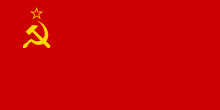
Soviet patriotism is the socialist patriotism involving emotional and cultural attachment of the Soviet people to the Soviet Union as their homeland. [1] It is also referred to as Soviet nationalism. [2]

Soviet patriotism is the socialist patriotism involving emotional and cultural attachment of the Soviet people to the Soviet Union as their homeland. [1] It is also referred to as Soviet nationalism. [2]


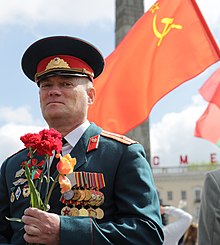
Stalin emphasized a centralist Soviet socialist patriotism that spoke of a collective "Soviet people" and identified Russians as being the "elder brothers of the Soviet people". [3] During World War II, Soviet socialist patriotism and Russian nationalism merged, portraying the war not just as a struggle of communists versus fascists, but more as a struggle for national survival. [3] During the war, the interests of the Soviet Union and the Russian nation were presented as the same, and as a result Stalin's government embraced Russia's historical heroes and symbols, and established a de facto alliance with the Russian Orthodox Church. [3] The war was described by the Soviet government as the Great Patriotic War. [3] After the war, nationalism was officially included into the ideology of the Soviet Union. Nationalities deemed "unreliable" were persecuted, and there were widespread deadly deportations during the Second World War. [4]
Nikita Khrushchev moved the Soviet government's policies away from Stalin's reliance on Russian nationalism. [3] Khrushchev promoted the notion of the people of the Soviet Union as being a supranational "Soviet People" that became state policy after 1961. [5] This did not mean that individual ethnic groups lost their separate identities or were to be assimilated but instead promoted a "brotherly alliance" of nations that intended to make ethnic differences irrelevant. [6] At the same time, Soviet education emphasized an "internationalist" orientation. [6] Many non-Russian Soviet people suspected this "Sovietization" to be a cover for a new episode of "Russification", in particular because learning the Russian language was made a mandatory part of Soviet education, and because the Soviet government encouraged ethnic Russians to move outside of Russia and settle in other Soviet republics. [6]
Efforts to achieve a united Soviet identity were severely damaged by the severe economic problems in the Soviet Union in the 1970s and 1980s resulting in a wave of anti-Soviet sentiment among non-Russians and Russians alike. [6] Mikhail Gorbachev presented himself as a Soviet patriot dedicated to address the country's economic and political challenges, but he was unable to restrain the rising regional and sectarian ethnic nationalism, with the USSR breaking up in 1991. [6]
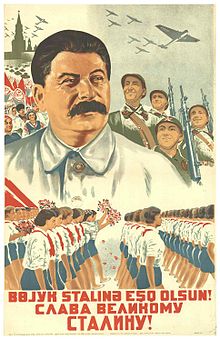
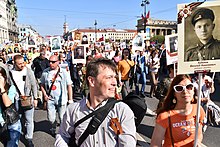
Under the outlook of international communism that was especially strong at the time, Lenin separated patriotism into what he defined as proletarian, socialist patriotism from bourgeois nationalism. [1] Lenin promoted the right of all nations to self-determination and the right to unity of all workers within nations, but he also condemned chauvinism and claimed there were both justified and unjustified feelings of national pride. [7] Lenin explicitly denounced conventional Russian nationalism as "Great Russian chauvinism", and his government sought to accommodate the country's multiple ethnic groups by creating republics and sub-republic units to provide non-Russian ethnic groups with autonomy and protection from Russian domination. [3] Lenin also sought to balance the ethnic representation of leadership of the country by promoting non-Russian officials in the Communist Party of the Soviet Union to counter the large presence of Russians in the Party. [3] However, even at this early period the Soviet government appealed at times to Russian nationalism when it needed support - especially on the Soviet borderlands in the Soviet Union's early years. [3]
Contemporary Chinese nationalism in the People's Republic of China, in particular the variant endorsed by the Communist Party of China has been said to have been modelled on Soviet nationalism. [3]
In modern day Russia, the Communist Party of the Russian Federation is often said to follow the ideology of Soviet patriotism. [8]
In many post-Soviet states such as Russia, Ukraine, Moldova, Belarus, Kazakhstan and others, there exists nostalgia for the Soviet Union, primarily among the older generation of people. [9] [10] Soviet symbolism and propaganda has been utilized by the Russian forces during the Russo-Ukrainian War (especially during the 2022 Russian invasion of Ukraine), to legitimize the actions of the Russian forces in Ukraine.

Leninism is a political ideology developed by Russian Marxist revolutionary Vladimir Lenin that proposes the establishment of the dictatorship of the proletariat led by a revolutionary vanguard party as the political prelude to the establishment of communism. Lenin's ideological contributions to the Marxist ideology relate to his theories on the party, imperialism, the state, and revolution. The function of the Leninist vanguard party is to provide the working classes with the political consciousness and revolutionary leadership necessary to depose capitalism.
Marxism–Leninism is a communist ideology that became the largest faction of the communist movement in the world in the years following the October Revolution. It was the predominant ideology of most communist governments throughout the 20th century. It was developed in Russia by Joseph Stalin and drew on elements of Bolshevism, orthodox Marxism, and Leninism. It was the state ideology of the Soviet Union, Soviet satellite states in the Eastern Bloc, and various countries in the Non-Aligned Movement and Third World during the Cold War, as well as the Communist International after Bolshevization.

Russification, or Russianization, is a form of cultural assimilation in which non-Russians, whether involuntarily or voluntarily, give up their culture and language in favor of the Russian culture and the Russian language.

An index of articles related to the former nation known as the Soviet Union. It covers the Soviet revolutionary period until the dissolution of the Soviet Union. This list includes topics, events, persons and other items of national significance within the Soviet Union. It does not include places within the Soviet Union, unless the place is associated with an event of national significance. This index also does not contain items related to Soviet Military History.
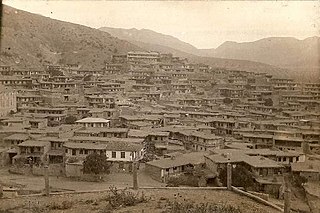
From 1930 to 1952, the government of the Soviet Union, on the orders of Soviet leader Joseph Stalin under the direction of the NKVD official Lavrentiy Beria, forcibly transferred populations of various groups. These actions may be classified into the following broad categories: deportations of "anti-Soviet" categories of population, deportations of entire nationalities, labor force transfer, and organized migrations in opposite directions to fill ethnically cleansed territories. Dekulakization marked the first time that an entire class was deported, whereas the deportation of Soviet Koreans in 1937 marked the precedent of a specific ethnic deportation of an entire nationality.
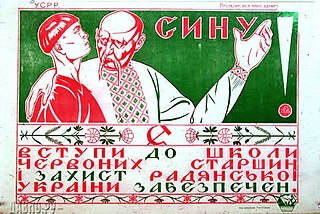
Korenizatsiia was an early policy of the Soviet Union for the integration of non-Russian nationalities into the governments of their specific Soviet republics. In the 1920s, the policy promoted representatives of the titular nation, and their national minorities, into the lower administrative levels of the local government, bureaucracy, and nomenklatura of their Soviet republics. The main idea of the korenizatsiia was to grow communist cadres for every nationality. In Russian, the term korenizatsiya (коренизация) derives from korennoye naseleniye. The policy practically ended in the mid-1930s with the deportations of various nationalities.

Russian nationalism is a form of nationalism that promotes Russian cultural identity and unity. Russian nationalism first rose to prominence as a Pan-Slavic enterprise during the 19th century Russian Empire, and was repressed during the early Bolshevik rule. Russian nationalism was briefly revived through the policies of Joseph Stalin during and after the Second World War, which shared many resemblances with the worldview of early Eurasianist ideologues.
National communism is a term describing various forms in which Marxism–Leninism and socialism has been adopted and/or implemented by leaders in different countries using aspects of nationalism or national identity to form a policy independent from communist internationalism. National communism has been used to describe movements and governments that have sought to form a distinctly unique variant of communism based upon distinct national characteristics and circumstances, rather than following policies set by other socialist states, such as the Soviet Union.
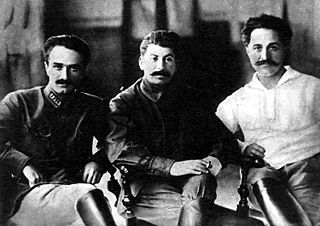
The Georgian affair of 1922 was a political conflict within the Soviet leadership about the way in which social and political transformation was to be achieved in the Georgian SSR. The dispute over Georgia, which arose shortly after the forcible Sovietization of the country and peaked in the latter part of 1922, involved local Georgian Bolshevik leaders, led by Filipp Makharadze and Budu Mdivani, on one hand, and their de facto superiors from the Russian SFSR, particularly Joseph Stalin and Grigol Ordzhonikidze, on the other hand. The content of this dispute was complex, involving the Georgians' desire to preserve autonomy from Moscow and the differing interpretations of Bolshevik nationality policies, and especially those specific to Georgia. One of the main points at issue was Moscow's decision to amalgamate Georgia, Armenia and Azerbaijan into Transcaucasian SFSR, a move that was staunchly opposed by the Georgian leaders who urged for their republic a full-member status within the Soviet Union.

Abdurakhman Genazovich Avtorkhanov was a Soviet historian and Kremlinologist of Chechen origin who during the Cold War authored popular books on the Soviet Union and its ruling system. He wrote under several Russian pseudonyms, but since the Dissolution of the Soviet Union some of his works have been republished under his real name.

The deportation of the Chechens and Ingush, or Ardakhar Genocide, and also known as Operation Lentil, was the Soviet forced transfer of the whole of the Vainakh populations of the North Caucasus to Central Asia on 23 February 1944, during World War II. The expulsion was ordered by NKVD chief Lavrentiy Beria after approval by Soviet leader Joseph Stalin, as a part of a Soviet forced settlement program and population transfer that affected several million members of ethnic minorities in the Soviet Union between the 1930s and the 1950s.

The Russification of Ukraine was a system of measures, actions and legislations undertaken by the Imperial Russian and later Soviet authorities to strengthen Russian national, political and linguistic positions in Ukraine.

The Russian Soviet Federative Socialist Republic, previously known as the Russian Soviet Republic and the Russian Socialist Federative Soviet Republic, as well as being unofficially referred to as Soviet Russia, the Russian Federation, or simply Russia, was an independent federal socialist state from 1917 to 1922, and afterwards the largest and most populous constituent republic of the Soviet Union (USSR) from 1922 to 1991, until becoming a sovereign part of the Soviet Union with priority of Russian laws over Union-level legislation in 1990 and 1991, the last two years of the existence of the USSR. The Russian SFSR was composed of sixteen smaller constituent units of autonomous republics, five autonomous oblasts, ten autonomous okrugs, six krais and forty oblasts. Russians formed the largest ethnic group. The capital of the Russian SFSR and the USSR as a whole was Moscow and the other major urban centers included Leningrad, Stalingrad, Novosibirsk, Sverdlovsk, Gorky and Kuybyshev. It was the first socialist state in the world.
Great Russian chauvinism is a term defined by the early Soviet government officials, most notably Vladimir Lenin, to describe an ideology of the "dominant exploiting classes of the nation, holding a dominant (sovereign) position in the state, declaring their nation as the "superior nation". Lenin promoted an idea for the Bolshevik party to defend the right of oppressed nations within the former Russian Empire to self-determination and equality as well as the language-rights movement of the newly-formed republics.
Socialist patriotism is a form of patriotism promoted by Marxist–Leninist movements. Socialist patriotism promotes people living within Marxist–Leninist countries to adopt a "boundless love for the socialist homeland, a commitment to the revolutionary transformation of society [and] the cause of communism". Marxist–Leninists claim that socialist patriotism is not connected with nationalism, as Marxists and Marxist–Leninists denounce nationalism as a bourgeois ideology developed under capitalism that sets workers against each other. Socialist patriotism is commonly advocated directly alongside proletarian internationalism, with communist parties regarding the two concepts as compatible with each other. The concept has been attributed by Soviet writers to Karl Marx and Vladimir Lenin.

The history of Soviet Russia and the Soviet Union (USSR) reflects a period of change for both Russia and the world. Though the terms "Soviet Russia" and "Soviet Union" often are synonymous in everyday speech, when referring to the foundations of the Soviet Union, "Soviet Russia" often specifically refers to brief period between the October Revolution of 1917 and the creation of the Soviet Union in 1922.
The Chechen-Slav ethnic clashes took place from 1958 to 1965 in the North Caucasus, upon ethnic tensions between Slavic settlers and local Chechens and Ingushs. The violence began in 1958, upon a conflict between a Russian sailor and an Ingush youngster over a girl, in which the Russian was fatally injured. The incident quickly deteriorated into mass ethnic riots in Grozny and surroundings, as Slavic mobs attacked Chechens and Ingushs and looted property throughout the region for 4 days. Ethnic clashes continued through 1960s, and in 1965 some 16 clashes were reported, taking tall of 185 severe injuries, 19 of them fatal. In the late 1960s, the region calmed down and the Chechen-Russian conflict came to its lowest point until the dissolution of the Soviet Union and the eruption of Chechen Wars in the 1990s.
Proletarian internationalism, sometimes referred to as international socialism, is the perception of all proletarian revolutions as being part of a single global class struggle rather than separate localized events. It is based on the theory that capitalism is a world-system and therefore the working classes of all nations must act in concert if they are to replace it with communism.
Soviet leaders and authorities officially condemned nationalism and proclaimed internationalism, including the right of nations and peoples to self-determination. The Soviet Union claimed to be supportive of self-determination and rights of many minorities and colonized peoples. However, it significantly marginalized people of certain ethnic groups designated as "enemies of the people", pushed their assimilation, and promoted chauvinistic Russian nationalistic and settler-colonialist activities in their lands. Whereas Vladimir Lenin had supported and implemented policies of korenization, Joseph Stalin reversed much of the previous policies, signing off on orders to deport and exile multiple ethnic-linguistic groups brandished as "traitors to the Fatherland", including the Balkars, Crimean Tatars, Chechens, Ingush, Karachays, Kalmyks, Koreans and Meskhetian Turks, with those, who survived the collective deportation to Siberia or Central Asia, were legally designated "special settlers", meaning that they were officially second-class citizens with few rights and were confined within small perimeters. After the death of Stalin, Nikita Khrushchev criticized the deportations based on ethnicity in a secret section of his report to the 20th Congress of the Communist Party of the Soviet Union, describing them as "rude violations of the basic Leninist principles of the nationality policy of the Soviet state". Soon thereafter, in the mid- to late 1950s, some deported peoples were fully rehabilitated, having been allowed the full right of return, and their national republics were restored — except for the Koreans, Crimean Tatars, and Meskhetian Turks, who were not granted the right of return and were instead forced to stay in Central Asia. The government subsequently took a variety of measures to prevent such deported peoples from returning to their native villages, ranging from denying residence permits to people of certain ethnic groups in specific areas, referring to people by incorrect ethnonyms to minimize ties to their homeland, arresting protesters for requesting the right of return and spreading racist propaganda demonizing ethnic minorities.
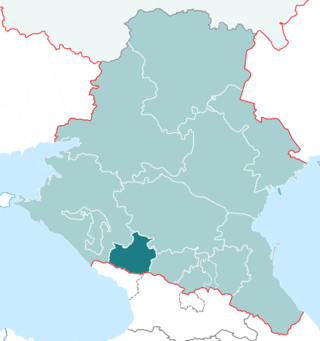
The Deportation of the Karachays, codenamed Operation Seagull, was the Soviet government's forcible transfer of the entire Karachay population from the North Caucasus to Central Asia, mostly to the Kazakh and Kyrgyzstan SSRs, in November 1943, during World War II. The expulsion was ordered by NKVD chief Lavrentiy Beria, after it was approved by Soviet Premier Joseph Stalin. Nearly 70,000 Karachays of the Caucasus were deported from their native land. The crime was a part of a Soviet forced settlement program and population transfer that affected several million members of non-Russian Soviet ethnic minorities between the 1930s and the 1950s.